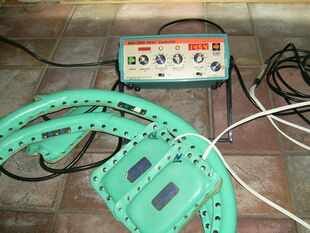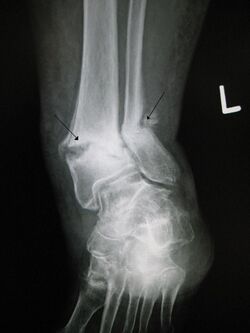Physics:Pulsed electromagnetic field therapy
| Pulsed electromagnetic field therapy | |
|---|---|
 Drolet's 1990 Rhumart system, a PEMF device. | |
| Other names | pulsed magnetic therapy, pulse magnetotherapy (PEMF) |
Pulsed electromagnetic field therapy (PEMFT), also known as low field magnetic stimulation (LFMS), and tumor treating fields (TTF) uses electromagnetic fields in an attempt to heal non-union fractures, glioblastomas (brain tumors) [1] and depression.[2] By 2007 the FDA had cleared several such stimulation devices.[3]
In 2013 the U.S. Food and Drug Administration (FDA) warned a manufacturer for promoting the device for unapproved uses such as cerebral palsy and spinal cord injury.[4]
Use
Delayed- and non-union fractures
The mechanism of osteogenesis is not clear.[5] While PEMF therapy is claimed to offer some benefit in the treatment of fractures, the evidence is inconclusive and is insufficient to inform current clinical practice.[6]
History
Electromagnetic field therapy has been in use since the invention of electricity. It was widely adopted in East and Western Europe but its use was restricted to animals in North America until recently.[when?][7] Veterinarians became the first health professionals to use PEMF therapy, usually to heal broken legs in racehorses.[8] In 2004, a pulsed electromagnetic field system was approved by the FDA as an adjunct to cervical fusion surgery in patients at high risk for non-fusion.[8] On 13 October 2015 the FDA reclassified PEMF devices from the Class 3 category to a Class 2 status. PEMF devices that have been FDA cleared to make health claims that require a doctor's prescription for use.[9]
Although electricity’s potential to aid bone healing was reported as early as 1841, it was not until the mid-1950s that scientists seriously studied the subject. During the 1970s, Bassett and his team introduced a new approach for the treatment of delayed fractures, a technique that employed a very specific biphasic low frequency signal[10][11][12][13] to be applied for non-union/delayed fractures. The use of electrical stimulation in the lumbosacral region was first attempted by Alan Dwyer of Australia. In 1974, he reported successful initiation of graft incorporation in 11 of 12 fusion patients.[14][15]
Wellness devices
The original PEMF devices consisted of a Helmholtz coil which generated a magnetic field. The patient's body was placed inside the magnetic field to deliver treatment. Today, the majority of PEMF wellness devices resemble a typical yoga mat in dimensions but are slightly thicker to house several flat spiral coils to produce an even electromagnetic field. A frequency generator is then used to energize the coils to create a pulsed electromagnetic field. A wide variety of professional and consumer PEMF devices are sold and marketed as FDA registered wellness devices.[9] The majority are manufactured in Germany, Austria and Switzerland and are imported into North America as electric massagers or full body electric yoga mats. They are either placed on a massage table for clinical use or directly on the floor in the home to practice simple yoga postures. The companies that sell and manufacture them as "general wellness products" are not permitted to make medical claims of effectiveness in treating disease.[9]
Research
Knee osteoarthritis
A 2013 review found that evidence was of very low quality, there might be a benefit for improved function, and there was no evidence for benefit for pain.[16]
Depression
Use of pulsed electromagnetic field therapy has been studied for depression.[17]
See also
- Electromagnetic Therapy (alternative medicine)
- Pulsed radiofrequency
References
- ↑ "Premarket Approval (PMA)". https://www.accessdata.fda.gov/scripts/cdrh/cfdocs/cfpma/pma.cfm?id=P100034. Retrieved 21 May 2018.
- ↑ Martiny, K; Lunde, M; Bech, P (15 July 2010). "Transcranial low voltage pulsed electromagnetic fields in patients with treatment-resistant depression.". Biological Psychiatry 68 (2): 163–9. doi:10.1016/j.biopsych.2010.02.017. PMID 20385376.
- ↑ Markov, Marko S (2007). "Expanding Use of Pulsed Electromagnetic Field Therapies". Electromagnetic Biology & Medicine 26 (3): 257–274. doi:10.1080/15368370701580806. PMID 17886012.
- ↑ "Warning Letters - Curatronic Ltd. 1/9/13" (in en). https://www.fda.gov/ICECI/EnforcementActions/WarningLetters/ucm335343.htm. Retrieved 7 January 2018.
- ↑ Boopalan, PRJVC; Chittaranjan, Samuel B; Balamurugan, Ramadass; Nandakumar, NS; Sabareeswaran, A; Mohanty, Mira (August 2009). "Pulsed electromagnetic field (PEMF) treatment for fracture healing". Current Orthopaedic Practice 20 (4): 423–428. doi:10.1097/BCO.0b013e318198e8b2.
- ↑ Griffin, XL; Costa, ML; Parsons, N; Smith, N (13 April 2011). "Electromagnetic field stimulation for treating delayed union or non-union of long bone fractures in adults.". The Cochrane Database of Systematic Reviews (4): CD008471. doi:10.1002/14651858.CD008471.pub2. PMID 21491410.
- ↑ Ross Roeser; Michael Valente (2007). AUDIOLOGY, 3-Volume Set: Diagnosis, Treatment and Practice Management. 342: Thieme. pp. 2000. ISBN 1604066970. https://books.google.com/books?id=258YfTJpgl4C&pg=RA2-PA342&dq=electromagnetic+therapy+animals+in+North+America#v=onepage&q=electromagnetic%20therapy%20animals%20in%20North%20America&f=false.
- ↑ 8.0 8.1 "Electrical stimulation of the spine as an adjunct to spinal fusion procedures". Blue Cross & Blue Shield of Mississippi. Archived from the original on 2015-04-02. https://web.archive.org/web/20150402122818/http://www.bcbsms.com/index.php/index.php?id=200&action=viewPolicy&path=%2Fpolicy%2Femed%2FElectrical+Stimulation+of+the+Spine+as+an+Adjunct+to+Spinal+Fusion+Procedures.html&source=emed. "Pulsed electromagnetic field systems with FDA PMA include the EBI Bone Healing System from Electrobiology, Inc., which was first approved in 1979 and indicated for nonunions, failed fusions, and congenital pseudarthroses; and the Cervical-Stim from Orthofix, which was approved in 2004 as an adjunct to cervical fusion surgery in patients at high risk for non-fusion."
- ↑ 9.0 9.1 9.2 "General Wellness: Policy for Low Risk Devices - Guidance for Industry and Food and Drug Administration Staff". U.S. Food and Drug Administration. 29 July 2016. http://www.fda.gov/downloads/medicaldevices/deviceregulationandguidance/guidancedocuments/ucm429674.pdf. Retrieved 16 February 2016.
- ↑ Bassett CA, Pawluk RJ, Pilla AA; Pawluk; Pilla (1974). "Acceleration of fracture repair by electromagnetic fields. A surgically noninvasive method". Ann N Y Acad Sci 238: 242–62. doi:10.1111/j.1749-6632.1974.tb26794.x. PMID 4548330. Bibcode: 1974NYASA.238..242B.
- ↑ Bassett CA, Pawluk RJ, Pilla AA; Pawluk; Pilla (1974). "Augmentation of Bone Repair by Inductively Coupled Electromagnetic Fields". Science 184 (4136): 575–7. doi:10.1126/science.184.4136.575. PMID 4821958. Bibcode: 1974Sci...184..575B.
- ↑ Bassett CA, Pilla AA, Pawluk RJ; Pilla; Pawluk (1977). "A non-operative salvage of surgically-resistant pseudarthroses and non-unions by pulsing electromagnetic fields. A preliminary report". Clin Orthop 124 (124): 128–43. doi:10.1097/00003086-197705000-00017. PMID 598067.
- ↑ Bassett CA, Mitchell SN, Norton L, Pilla A; Mitchell; Norton; Pilla (1978). "Repair of non-unions by pulsing electromagnetic fields". Acta Orthop Belg 44 (5): 706–24. PMID 380258.[unreliable medical source?]
- ↑ Mackenzie, Donald, Francis D Veninga; Veninga (2004). "Reversal of delayed union of anterior cervical fusion treated with pulsed electromagnetic field stimulation: case report". Southern Medical Journal 97 (5): 519–524. doi:10.1097/00007611-200405000-00021. PMID 15180031.[unreliable medical source?]
- ↑ Bose, B (2001). "Outcomes after posterolateral lumbar fusion with instrumentation in patients treated with adjunctive pulsed electromagnetic field stimulation". Advances in Therapy 18 (1): 12–20. doi:10.1007/BF02850247. PMID 11512529.[unreliable medical source?]
- ↑ Negm, A; Lorbergs, A; Macintyre, NJ (September 2013). "Efficacy of low frequency pulsed subsensory threshold electrical stimulation vs placebo on pain and physical function in people with knee osteoarthritis: systematic review with meta-analysis.". Osteoarthritis and cartilage 21 (9): 1281–9. doi:10.1016/j.joca.2013.06.015. PMID 23973142.
- ↑ van Belkum, SM; Bosker, FJ; Kortekaas, R; Beersma, DG; Schoevers, RA (3 November 2016). "Treatment of depression with low-strength transcranial pulsed electromagnetic fields: A mechanistic point of view.". Progress in Neuro-Psychopharmacology & Biological Psychiatry 71: 137–43. doi:10.1016/j.pnpbp.2016.07.006. PMID 27449361.
Further reading
- Vavken, Patrick; Arrich, Ferdi; Schuhfried, Othmar; Dorotka, Ronald (2009-05-01). "Effectiveness of pulsed electromagnetic field therapy in the management of osteoarthritis of the knee: a meta-analysis of randomized controlled trials". Journal of Rehabilitation Medicine 41 (6): 406–411. doi:10.2340/16501977-0374. ISSN 1651-2081. PMID 19479151. https://www.ncbi.nlm.nih.gov/pubmedhealth/PMH0027512/.


